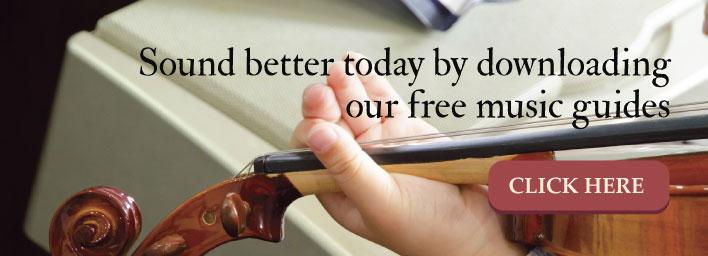
When learning to play any string instrument, knowing how to tune it properly—on your own, without assistance—is a critical first step to master. It’s nearly impossible to practice or achieve deliberate strides in improvement if your instrument is off pitch. So you need to be able to tune it without the help of your instructor. And while it can be a bit tricky at first, for most students, learning this fundamental skill is pretty basic when using a chromatic (or digital) tuner. However, tuning the cello requires a little more finesse, and the sequencing you use is extremely important.
To properly tune your cello you’ll need to be familiar with the pieces involved and how the whole instrument acts as a unit. Like similar wood-crafted instruments, the cello is susceptible to changes in humidity, temperature, and atmospheric pressure. These conditions are able to not only severely damage your cello if ignored, they affect how frequently you’ll need to tune the strings. As the wood expands and contracts, the tension in the strings is affected.
The Basics
The cello has four strings which are tuned in perfect fifths, similar to the violin. The notes are: C, G, D, and A, in ascending order of thickness. The low C on the cello corresponds to two octaves below middle C on the piano, and many students use a piano to tune their cellos.
The four tuning pegs located on the scroll and the four fine tuners located on the tailpiece of the cello are used to tighten and loosen the corresponding strings. However, the cello is like many stringed instruments in that the tension on the strings is used to secure the bridge and soundpost. Therefore, use caution when releasing the pressure.
Similar to other instruments, your cello strings are tuned from the open position. At first, you’ll want to rely solely on a digital tuner. Those that clip on to the peg box are quite inexpensive and very convenient to use. After you’ve developed good intonation, using a tuning fork and harmonics to keep your cello in tune will be just as easy.
Tuning Sequences
Basically, you can approach tuning your cello according to how many strings need tuned. Minor adjustments can be made using the fine tuners, but if the strings are really off pitch, you’ll need to use both the pegs and the tuners.
If more than two strings need tuned, use the sequence: C, G, D, A. Typically, the strings will need to be tightened because they lose tension over time and are very flat, although on rare occasions, climate changes will require that you loosen them. The method is as follows:
- Working with the open C string, gradually tighten it to bring it up in pitch until it is fairly close to the correct note. This is done by first plucking the string to generate a tone, and then gently turning and pushing the peg to tighten it, or loosen it with the opposite action, using the pitch guide on your digital tuner. But, be careful. Tuning pegs are conical in shape, so you must gently push them in as you are turning to ensure that they stay in place. Do not perfectly tune the string at this time—doing so will create uneven pressure on the bridge, plus each string affects the others, so you’ll need to adjust each string more than once anyway. It’s a good idea to leave yourself plenty of leeway.
- Perform the same action on the remaining strings, staying well below the pitch on each one.
- After the first pass, check your bridge alignment to ensure that the pressure you’ve applied hasn’t caused it to lean. It should remain perfectly perpendicular to the soundboard of the cello.
- Repeat the process, using smaller and smaller adjustments until you’ve progressively tightened all the strings, and they are very close to pitch.
- Now that you are within one note from the correct pitch, use your fine tuners to achieve a flawless tone. Another word of caution: Avoid having to tighten your fine tuner all the way—some designs will dent the soundboard when tightened to extreme.
Tuning Tips and No-no’s
- Never, ever remove or all of the strings of your cello at the same time.
- It’s a good idea to ensure that your fine tuners are loosened before your begin the tuning process.
- If you’re using a cello tuner, keep in mind that the plucking sounds won’t register until the string is within one note.
- Use cautious movements! Overtightening your strings can result in damage to your cello and your person—particularly the face and eyes, so be careful!
- Always ask your instructor or a trusted instrument dealer to help you if you need it.


